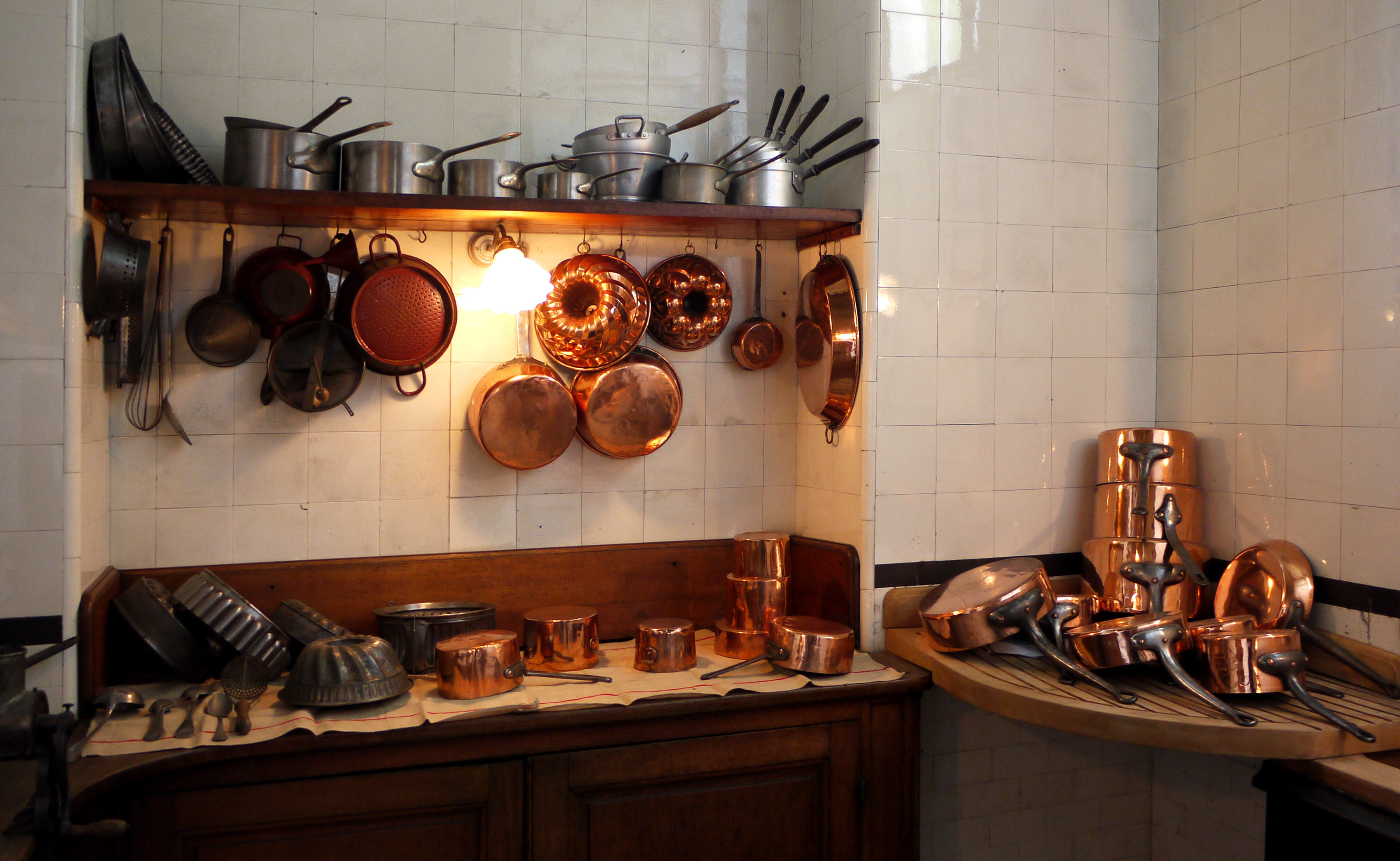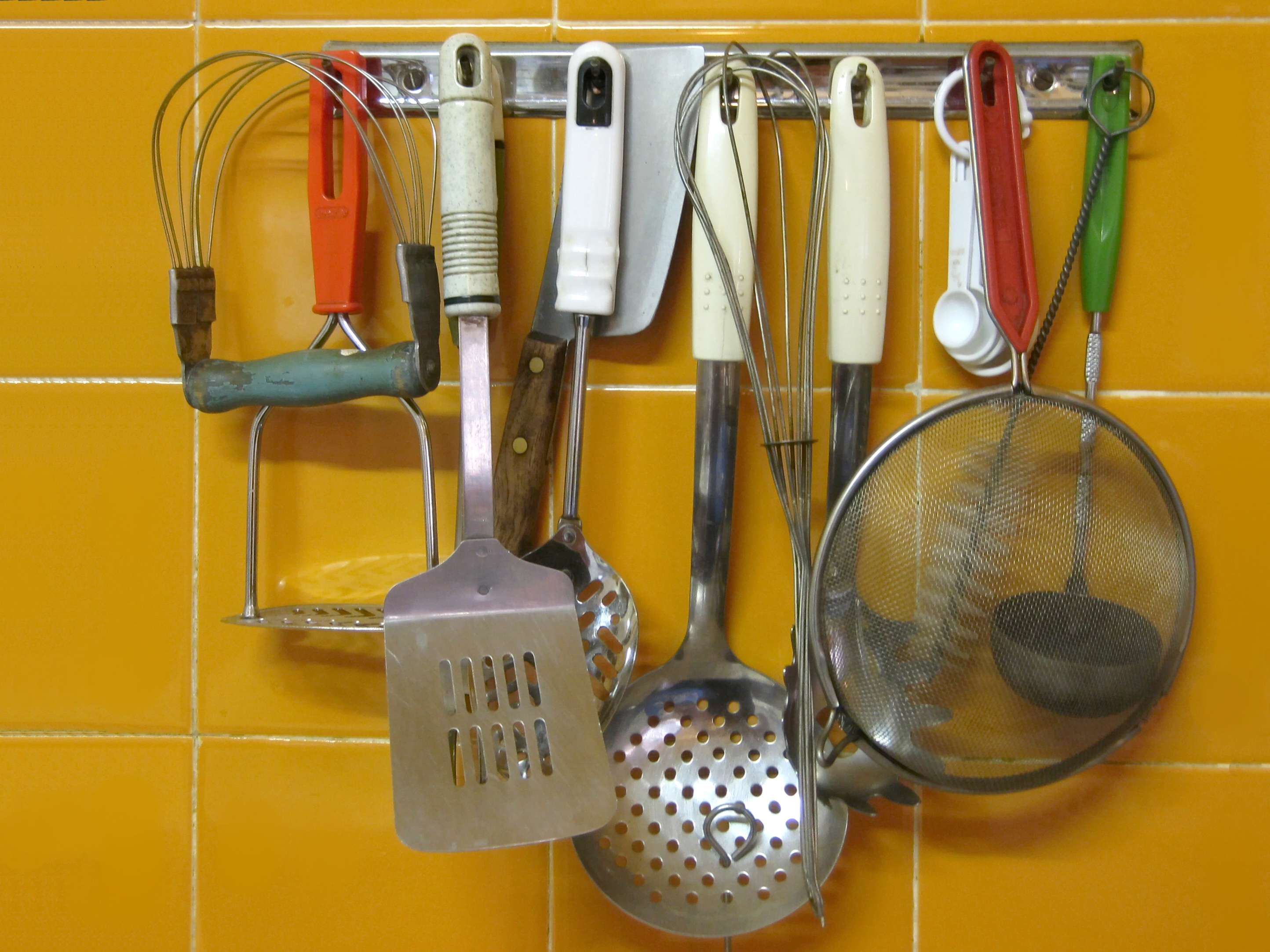|
Boil Over Preventer
A milk watcher, milk saver, pot watcher, pot minder, milk guard, or boil over preventer is a cooking utensil placed at the bottom of a pot to prevent the foaming boil-over of liquids by collecting small bubbles of steam into one large bubble. Description A milk watcher is a disk with a raised rim notched on one side (see images). Some milk savers are designed so they can be used with the obverse or reverse side facing up and appear to have two notches. The interior of the disk slants upward toward the notched side, creating a space just behind the notch where water vapor can collect. Water vapor trapped under the Milk Saver causes the notched side to rise up, releasing the water vapor and making a rattling noise. Explanation Normally, boiling water does not boil over. When fats, starches, and some other substances are present in boiling water, for example by adding milk or pasta, boiling over can occur. A film forms on the surface of the boiling liquid; for example, cream ca ... [...More Info...] [...Related Items...] OR: [Wikipedia] [Google] [Baidu] |
Cooking Utensil
A kitchen utensil is a small hand held tool used for food preparation. Common kitchen tasks include cutting food items to size, heating food on an open fire or on a stove, baking, grinding, mixing, blending, and measuring; different utensils are made for each task. A general purpose utensil such as a chef's knife may be used for a variety of foods; other kitchen utensils are highly specialized and may be used only in connection with preparation of a particular type of food, such as an egg separator or an apple corer. Some specialized utensils are used when an operation is to be repeated many times, or when the cook has limited dexterity or mobility. The number of utensils in a household kitchen varies with time and the style of cooking. A cooking utensil is a utensil for cooking. Utensils may be categorized by use with terms derived from the word "ware": kitchenware, wares for the kitchen; ovenware and bakeware, kitchen utensils that are for use inside ovens and for baking; ... [...More Info...] [...Related Items...] OR: [Wikipedia] [Google] [Baidu] |
Butterfat
Butterfat or milkfat is the fatty portion of milk. Milk and cream are often sold according to the amount of butterfat they contain. Composition Butterfat is mainly composed of triglycerides. Each triglyceride contains three fatty acids. Butterfat triglycerides contain the following amounts of fatty acids (by mass fraction):The quote values vary by 1–3% according to the source: Butterfat contains about 3% trans fat, which is slightly less than 0.5 grams per US tablespoon. Trans fats occur naturally in meat and milk from ruminants. The predominant kind of trans fat found in milk is vaccenic fatty acid. Trans fats may be also found in some industrially produced foods, such as shortenings obtained by hydrogenation of vegetable oils. In light of recognized scientific evidence, nutritional authorities consider all trans fats equally harmful for health and recommend that their consumption be reduced to trace amounts. However, two Canadian studies have shown that vaccenic acid ... [...More Info...] [...Related Items...] OR: [Wikipedia] [Google] [Baidu] |
Steam
Steam is a substance containing water in the gas phase, and sometimes also an aerosol of liquid water droplets, or air. This may occur due to evaporation or due to boiling, where heat is applied until water reaches the enthalpy of vaporization. Steam that is saturated or superheated is invisible; however, "steam" often refers to wet steam, the visible mist or aerosol of water droplets formed as water vapor condenses. Water increases in volume by 1,700 times at standard temperature and pressure; this change in volume can be converted into mechanical work by steam engines such as reciprocating piston type engines and steam turbines, which are a sub-group of steam engines. Piston type steam engines played a central role in the Industrial Revolution and modern steam turbines are used to generate more than 80% of the world's electricity. If liquid water comes in contact with a very hot surface or depressurizes quickly below its vapor pressure, it can create a steam explosion. ... [...More Info...] [...Related Items...] OR: [Wikipedia] [Google] [Baidu] |
Foam
Foams are materials formed by trapping pockets of gas in a liquid or solid. A bath sponge and the head on a glass of beer are examples of foams. In most foams, the volume of gas is large, with thin films of liquid or solid separating the regions of gas. Soap foams are also known as suds. Solid foams can be closed-cell or open-cell. In closed-cell foam, the gas forms discrete pockets, each completely surrounded by the solid material. In open-cell foam, gas pockets connect to each other. A bath sponge is an example of an open-cell foam: water easily flows through the entire structure, displacing the air. A sleeping mat is an example of a closed-cell foam: gas pockets are sealed from each other so the mat cannot soak up water. Foams are examples of dispersed media. In general, gas is present, so it divides into gas bubbles of different sizes (i.e., the material is polydisperse)—separated by liquid regions that may form films, thinner and thinner when the liquid phase drain ... [...More Info...] [...Related Items...] OR: [Wikipedia] [Google] [Baidu] |
Food Preparation Utensils
A kitchen utensil is a hand-held, typically small tool that is designed for food-related functions. Food preparation utensils are a specific type of kitchen utensil, designed for use in the preparation of food. Some utensils are both food preparation utensils and eating utensils; for instance some implements of cutlery – especially knives – can be used for both food preparation in a kitchen and as eating utensils when dining (though most types of knives used in kitchens are unsuitable for use on the dining table). In the Western world, utensil invention accelerated in the 19th and 20th centuries. It was fuelled in part by the emergence of technologies such as the kitchen stove and refrigerator, but also by a desire to save time in the kitchen, in response to the demands of modern lifestyles. [...More Info...] [...Related Items...] OR: [Wikipedia] [Google] [Baidu] |
Milk
Milk is a white liquid food produced by the mammary glands of mammals. It is the primary source of nutrition for young mammals (including breastfed human infants) before they are able to digestion, digest solid food. Immune factors and immune-modulating components in milk contribute to milk immunity. Early-lactation milk, which is called colostrum, contains antibody, antibodies that strengthen the immune system, and thus reduces the risk of many diseases. Milk contains many nutrients, including protein and lactose. As an agricultural product, dairy milk is Milking, collected from farm animals. In 2011, Dairy farming, dairy farms produced around of milk from 260 million dairy cows. India is the world's largest producer of milk and the leading exporter of skimmed milk powder, but it exports few other milk products. Because there is an ever-increasing demand for dairy products within India, it could eventually become a net importer of dairy products. New Zealand, Germany and the ... [...More Info...] [...Related Items...] OR: [Wikipedia] [Google] [Baidu] |





.jpg)